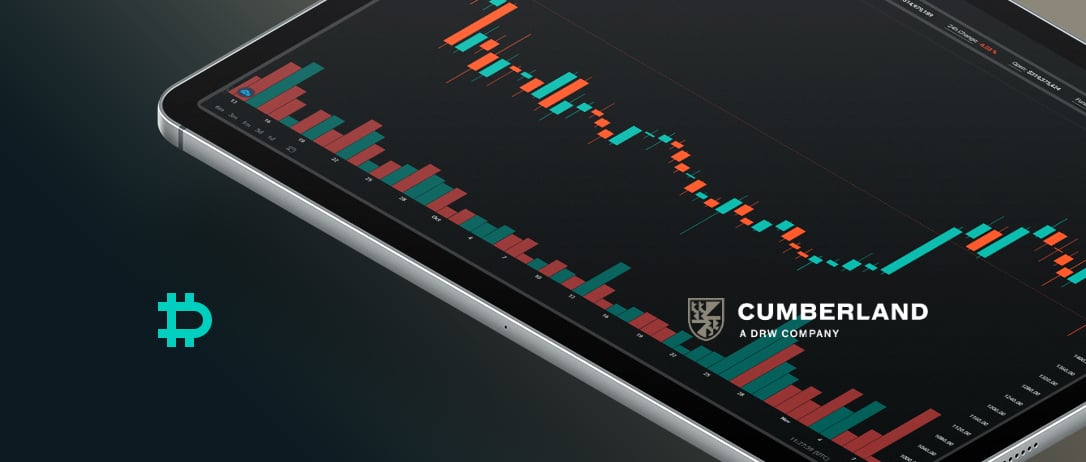
Cumberland is commenting on the recent volatility and potential opportunities to take advantage of it.
For further information about Cumberland, please visit Cumberland website here.
Last week was a big one for crypto, both from a price and a headline perspective. There’s been an interesting flow of price action, and it has felt in some ways like a throwback to 2021. The initial movement came from the macro space, where equities mostly recovered from a damaging April amidst positive trade developments. BTC had been stuck in a tension between comparisons to Gold, which had an amazing April, and equities, which reminded Bitcoiners that BTC was still broadly a risk asset. The easing of the macro headwinds allowed BTC to recover to the high $90ks, and the breakthrough came on Thursday, when BTC broke above $103k and has not really retraced since.
What is interesting here is the outperformance that this triggered in ETH. In the 2021 bull market, we would typically see alts perform as high-beta assets during upticks, but that was simply not the case during 2024, when alts would underperform during rallies. This resulted in ETH being one of the most-unloved assets of the cycle, which was probably why there was meaningful short interest on it heading into last week. BTC’s strength pushed ETH up towards $2200, and from there it accelerated; over the past week, ETH is up a staggering 36%, compared to BTC’s +8%, the largest weekly rally since May of ’21. In just two days, ETHBTC erased the losses it saw in March (before it moved uninspiringly sideways for the entire month of April). The last time ETHBTC saw this type of move was immediately following the Merge.
This leaves the market in an interesting spot. This rally could just be ETH-specific (and one could argue that it was driven by the Pectra upgrade, though it doesn’t really seem like this was the driver). However, if it is a return to the 2021 dynamics of high Beta, it could be an interesting week. During the 2021 era, BTC rallies would lead to ETH rallies, and then if the price of the majors held, alts would make a major catchup move and then often accelerate past. Again, this has not been the paradigm for the last year, and alts do seem hesitant to rally here. ETH was by far the best performer among L1s since the start of May; most alt L1s are in the 10-25% range. SOL, which is up 15% on the month, will probably be the best indicator of whether the market will return to beta dynamics; if it picks up some interest on the week, it could spread to the rest of the L1 sector.
There were headlines as well, though mostly in the sector least-associated with price: the stablecoin space. Stablecoins are one of the sole sectors within crypto that have found true product-market fit, so we view this as one of the key areas for sustainable infrastructure growth, though normally stablecoin headlines don’t have near-term price impact:
- Meta announced it is exploring stablecoin integrations.
- Stripe launched stablecoin-funded accounts in over 100 countries; their new features will not only allow pay-in and pay-out, but will also enable merchants to hold stablecoins
- Ramp launched a series of stablecoin-powered cards
- On the negative side, the stablecoin GENIUS bill failed its first vote in the Senate, with debate resuming on Monday.
It wouldn’t surprise to see continued volatility this week. Macro is not likely to quiet down, with trade deal headlines trickling through. As discussed above, BTC seems to be trading with strength just below its all-time high. Next week will feature prominent events from Solana and Avalanche, followed by Bitcoin Vegas, where JD Vance and David Sacks will speak. Intriguingly, thanks to the low realized volatility in April, upside vol in BTC is still fairly cheap, and backend vol has barely moved (BTC Sep-Dec vol is up less than 1v.) In the grand scheme of things, BTC implied vols are actually fairly close to their all-time lows, which almost certainly would not persist if BTC were to break through its previous ATH.
Disclaimer
Cumberland New York is licensed to engage in virtual currency business activity by the New York State Department of Financial Services. Here is a link to the disclosures on the Cumberland website.
An in-principle approval (IPA) reflects MAS’ view that a license may be issued to the applicant upon the fulfilment of specified conditions and provided there are no material adverse developments affecting the applicant. An IPA does not constitute a license at this juncture. MAS reserves the right to rescind the IPA in circumstances where it considers appropriate
AUTHOR(S)
